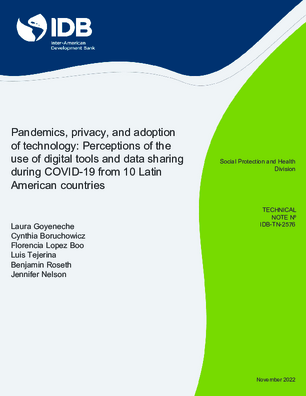Pandemics, Privacy, and Adoption of Technology: Perceptions of the Use of Digital Tools and Data Sharing During COVID-19 from 10 Latin American countries
Date issued
Nov 2022
Subject
Coronavirus;
Pandemic;
Digital Technology;
Technology Adoption;
E-Health;
Quarantine;
Health;
Science and Technology
JEL code
O33 - Technological Change: Choices and Consequences • Diffusion Processes;
I10 - Health: General
Category
Technical Notes
This study describes the perception, adoption, and acceptance factors involved in the deployment of digital technologies for public health in Latin America and considers the implications for future digital health interventions. We conducted a descriptive analysis using nationally representative data from a phone survey conducted in 2020 in 10 countries in Latin America. We found that early in the pandemic, in countries with existing applications, 74% of the population used a smartphone, 47% had knowledge of the government app to report symptoms, but only 2% reported using it. Those interviewed reported that they are willing to share their personal data during a pandemic (61%) 50 percentage points higher than in non-pandemic times, although understanding how their personal data was used by the government and private companies was extremely low. More than 70% reported that they would use an application to report symptoms and would use an app that accesses their location or that uses contact tracing technology to alert them about possible exposure. Also, at least half of the users agree with preventive measures against COVID-19 such as daily follow-up calls, tracking via GPS for quarantine enforcement, and daily visits. In all countries, adoption of digital technologies increases if individuals or their relatives report they are infected; it decreases when end-users do not trust the anonymity policies or are concerned about government surveillance. Yet, encouraging greater adoption of digital technologies strongly depends on who designed the technology. Results show that 73% of users would prefer an app designed by an international organization such as the WHO to an app designed by the local government (64%) or a telephone company (56%). The study concludes with a reflection on the promising results of digital technologies and discusses the importance of considering users perceptions, factors for acceptance, and trust when pursuing adoption of digital technologies.



